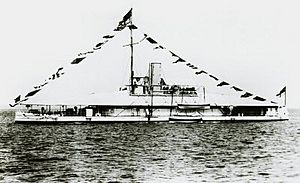HMS Magdala (1870) facts for kids
class="infobox " style="float: right; clear: right; width: 315px; border-spacing: 2px; text-align: left; font-size: 90%;"
| colspan="2" style="text-align: center; font-size: 90%; line-height: 1.5em;" | 
|} HMS Magdala was a special type of warship called a monitor. She was built for the Royal Navy in the late 1860s. Her main job was to protect the harbour of Bombay (now called Mumbai) in India.
The ship was ordered by the India Office for the Bombay Marine. At first, the plans for the ship were too expensive. So, a cheaper design was chosen instead. Even though these ships were only for harbour defence, Admiral George Alexander Ballard once said they were like "full-armoured knights riding on donkeys." This meant they were easy to avoid but very dangerous if you got too close. Magdala stayed in Bombay Harbour for her whole career, mostly doing gunnery practice. She was sold for scrap in 1903.
Contents
| History | |
|---|---|
| Name | HMS Magdala |
| Namesake | Battle of Magdala |
| Builder | Thames Ironworks & Shipbuilding Company |
| Cost | £132,400 |
| Laid down | 6 October 1868 |
| Launched | 2 March 1870 |
| Completed | November 1870 |
| Fate | Broken up, 1904 |
| General characteristics | |
| Class and type | Cerberus-class breastwork monitor |
| Displacement | 3,340 long tons (3,390 t) |
| Length | 225 ft (68.6 m) (p/p) |
| Beam | 45 ft (13.7 m) |
| Draught | 15 ft 3 in (4.6 m) |
| Installed power | 1,436 ihp (1,071 kW) |
| Propulsion | 2 shafts, 2 steam engines |
| Speed | 10 knots (19 km/h; 12 mph) |
| Range | 450 nmi (830 km; 520 mi) at 10 kn (19 km/h; 12 mph) |
| Complement | 155 |
| Armament | 2 × 2 - 10-inch rifled muzzle loaders |
| Armour |
|
Designing a Harbour Defender
In 1866, the India Office needed two floating batteries to protect Bombay. A "monitor" ship was suggested. Monitors were strong warships with heavy armour and large guns.
The first design was very expensive, costing £220,000. It would have had very thick armour. Because of the high cost, a simpler design was chosen. This new design was based on another ship, HMVS Cerberus, and cost £132,400.
These ships were about 225 feet (68.6 m) long and 45 feet (13.7 m) wide. They weighed about 3,340 long tons (3,390 t) when fully loaded. Each ship had a crew of 155 officers and sailors.
How the Ship Moved
Magdala had two powerful steam engines. These engines turned two propellers, which pushed the ship through the water. The ship's boilers created steam with a pressure of 30 psi (207 kPa; 2 kgf/cm2).
During her tests in 1870, the engines made enough power for the ship to reach a top speed of 10.67 knots (19.76 km/h; 12.28 mph). Magdala could carry 220 long tons (220 t) of coal. This was enough fuel to travel about 450 nmi (830 km; 520 mi) at a speed of 10 kn (19 km/h; 12 mph).
Ship's Weapons
The Cerberus-class ships, like Magdala, had two large 10-inch guns. These were "rifled muzzle-loading" guns, meaning they had grooves inside the barrel to make the shell spin, and they were loaded from the front. Each gun was in a special rotating tower called a gun turret, which was moved by hand.
The shells fired by these 10-inch guns weighed 407 pounds (184.6 kg). The guns themselves were very heavy, weighing 18 long tons (18 t). They could fire shells at a speed of 1,365 ft/s (416 m/s). These guns were strong enough to break through 12.9 inches (330 mm) of wrought iron armour from 100 yards (91 m) away. They could fire both solid shots and explosive shells. Later, in 1892, Magdala was updated with four newer breech-loading 8-inch guns. These guns were loaded from the back.
Ship's Protection
The Cerberus-class ships were built to be very tough. They had a thick belt of wrought iron armour around their waterline. This belt was 8 inches (203 mm) thick in the middle and 6 inches (152 mm) thick at the ends.
The main part of the ship above the waterline, called the breastwork, was also heavily armoured. It had 8–9 inches (203–229 mm) of wrought iron. The gun turrets had 10 inches (250 mm) of armour on the front and 9 inches (230 mm) on the sides and back. All this vertical armour was backed by thick teak wood, about 9–11 inches (229–279 mm) deep, to absorb impacts. The decks were 1.5 inches (38.1 mm) thick and also backed by 10 inches (250 mm) of teak.
Life of the Ship
HMS Magdala began construction on 6 October 1868. She was built by the Thames Ironworks in Leamouth, London. The ship was launched into the water on 2 March 1870 and finished in November 1870.
To get to India, Magdala had three temporary masts added. She sailed all the way to India using her sails, even in the middle of winter. Both her builders and the Royal Navy believed she was strong enough to make the journey safely without an escort. After arriving in India, Magdala's entire career was spent in Bombay Harbour. She only made short trips out to sea for firing practice. The ship was sold for scrap in January 1903.

